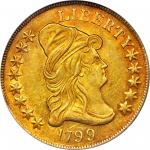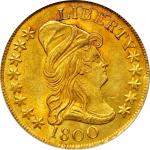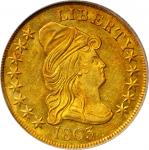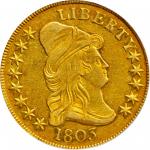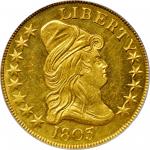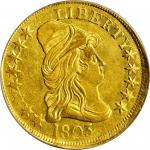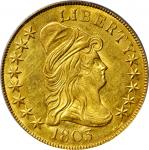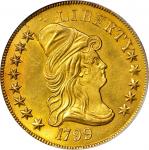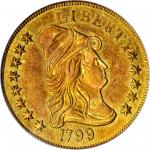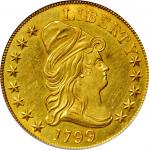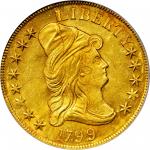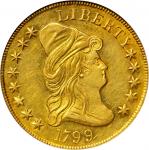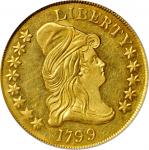1799 Capped Bust Right Eagle. BD-9, Taraszka-21. Rarity-6+. Large Obverse Stars. AU-58 (PCGS). CAC.Type and Style: Type II: Capped Bust Right, Heraldic Eagle. Style VII: Head of 1795 with 13 large stars arranged eight left, five right; Reverse of 1799 with 13 small stars in the field below the clouds and a short, thick neck on the eagle. The head and eagle punches are attributed to hubs prepared by Robert Scot.Die Variety: BD-9, Taraszka-21, Breen 5-F, HBCC-3190. This variety represents the first of two uses of this obverse die and the only use of this reverse die. The large size of the stars is definitive for this obverse die, the only one of the 1799 Large Obverse Stars Guide Book variety. Closer inspection also reveals repunching to the second digit 9 in the date. On the reverse, the tip of a leaf in the olive branch points to the space between the letters IC in AMERICA and the lowest berry in the branch is past the final letter A.Die State: BD Die State a/b. This is the only confirmed die state of this variety, although a perfect state of the reverse likely exists. The obverse is perfect with no clashing, lapping or cracks. The reverse is lightly lapped with a series of die lines arcing through the top of the recessed stripes in the shield. These are curious since lapping lines on early eagles are usually straight and vertical. The arcing lines on examples of this variety may represent an experimental type of lapping.Estimated Mintage for the Issue: The conventionally accepted mintage has been 37,449 coins for the 1799 Capped Bust Right eagle issue, based on Walter Breens assumption that all of the coins delivered between May 14, 1799, and September 4, 1800, were from 1799-dated dies. After careful study, Dannreuther provides a revised range of 31,750 to 46,250 pieces produced, the lower estimate allowing for the possibility that some 1797 BD-3 and/or BD-4 coins were included in Breens 37,499-piece mintage, and the upper estimate allowing for the possibility that some 1799-dated eagles were also included in later deliveries.Estimated Mintage for the Variety: Dannreuther estimates that 750 to 1,250 examples were coined from the 1799 BD-9 dies.Estimated Surviving Population for the Variety: Only 14 to 18 coins are believed extant in all grades (per Dannreuther).Strike: This is a generally bold example with the central design elements sharply to fully defined. Denticulation is full around both sides, but we do note softness of detail to isolated peripheral features, including stars 1 to 3 on the obverse, the bottom of Libertys portrait, stars 2 to 4 and the adjacent clouds on the reverse, and the eagles tail and wing tips.Surfaces: Both sides are fully reflective in the fields with a prooflike finish. Pretty light golden yellow color is seen throughout, and the surfaces are free of all but a few trivial handling marks that are consistent with the assigned grade. Four tiny obverse carbon spots at the upright of the letter R in LIBERTY, below the right foot of the same letter, below the letter Y, and inside star 9 are the most useful identifying features.Commentary: BD-9 and BD-10 are the only two varieties of the 1799 eagle that display large stars on the obverse, and they were struck from the same obverse die. We know that these varieties were the last produced with the 1799 date because the Large Obverse Stars style continues through the end of the circulation strike Capped Bust Right series in 1804. Apparently the small obverse star punch broke during production of one of the earlier 1799-dated obverses, and was replaced by a device punch for a large, thick star. Interestingly, this large, thick star punch was itself replaced with a large, thin star punch beginning with the obverse die of the 1801 BD-2 variety, although the 1804 BD-1 Crosslet 4 obverse was also created using the large, thick star punch (see below, in our description for the 1804 eagle).As with so many scarce to rare early eagle varieties, the elusiveness of 1799 BD-9 is due to some unknown damage befalling one of the dies, in this case the reverse. Since there are no known examples of this variety struck from a terminal state of the reverse, whatever caused that die to fail must have happened so suddenly that Mint employees retired the die before it struck more than a few additional coins, if any at all. The damage certainly occurred early in the press run, for no more than 1,250 coins are believed to have been struck from this pairing (per Dannreuther), explaining the scarcity of survivors. The obverse die remained perfect, however, for that is the earliest state known in the 1799 BD-10 marriage.With fewer than 20 coins believed extant (perhaps fewer than 15), 1799 BD-9 represents a significant find for the specialist whenever an example appears on the market. One of numerous highlights in the Taraszka Collection, and sure to see spirited bidding at auction.This coin is included in the list of Significant Specimens for the variety in the Taraszka early eagle reference.From the Anthony J. Taraszka Collection. Earlier from our (Stacks) S.S. Forrest, Jr. Collection sale, September 1972, lot 403; Superiors ANA Sale of August 1975, lot 1535; our (Bowers and Merenas) sale of the Harry W. Bass, Jr. Collection, Part III, May 2000, lot 564.

